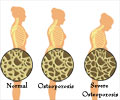
‘Restoring a more youthful balance could be a novel strategy for reducing age-associated problems likes osteoporosis and the impaired ability to heal bone breaks. ’
Tweet it Now
"You want it sort of in that sweet spot," says Dr. William D. Hill, a longtime stem cell researcher at MCG now on the faculty at the Medical University of South Carolina. "What we are trying to do is dial it back down from where it's being overexpressed due to factors like aging and oxidative stress and suppression of estrogen, and bring it back into a range that would effectively allow more normal bone formation," says Hill, also a corresponding author. About 30 percent of postmenopausal women in the United States and Europe have osteoporosis, according to the International Osteoporosis Foundation. At least 40 percent of these women and 15-30 percent of men will sustain one or more fractures in their lifetime, the foundation says, and one fracture puts them at increased risk for others.
Mesenchymal stem cells can differentiate into the major components of our skeleton: bone-forming osteoblasts; actual bone cells or osteocytes, made by osteoblasts; cartilage-cells called chondrocytes; as well as fat cells, or adipocytes.
SDF-1 is a key signaling molecule that helps regulate the differentiation of stem cells into these cells, the MCG research team has shown. SDF-1 has a myriad of other roles as well, including helping mesenchymal stem cells get to the right spot during bone formation and bone repair and protecting cells from the ravages of oxidative stress.
It was SDF-1's clear significance in bone health - and the fact that it declines with age - that got the scientists interested in how it's regulated.
Advertisement
Now putting the pieces together they speculated - and have found - that higher oxidative stress elevates microRNA-141-3p expression, which in turn decreases SDF-1 levels. In both mice and human mesenchymal stem cells, they found levels of microRNA-141-3p were low in young cells but levels were tripled or more in older cells. They found essentially the opposite for SDF-1 levels.
Advertisement
As part of testing their hypothesis from all directions, the scientists also added microRNA-141-3p to cells and watched bone function get worse, then used the inhibitor again and saw improvement. Clinical-grade drugs, like the research drug they used to inhibit microRNA-141-3p and that might target other members of the micro-RNA 141 family as well, could one day be an effective way to help mesenchymal stem cells remain focused on making bone in the face of age and other conditions, Fulzele says.
At least in their cell studies: "It normalizes bone function. We think clinical-grade inhibitor may help us do the same in people," the bone biologist says.
Hill says that a patch of endogenous or synthetic RNA could also be an option for precisely targeting errant microRNAS, which are usually the molecules doing the regulating. They are now looking to move into animal models and look at a wide array of other factors like what happens to fat production, and can they improve fracture healing in a model of aging and/or prevent or at least reduce osteoporosis. Fulzele also wants to know if higher physical activity levels, which tend to diminish with age, can also help restore a healthier balance of microRNA-141-3p and SDF-1.
They also are looking at other members of the microRNA-141 family and how/if they interact with other family members to cause problems as we age, Hill says. "We have identified a number of microRNAs that change in the bone marrow stem cells with aging and we are going after each one of these to understand how they are working and are they working together or independently," Hill adds. "We are starting to take more of a biological systems approach, not just changing one target molecule, but looking at how this network of molecules is changed with age or disease and how we can reach in and sort of reset these different pathways."
The scientists note that other genes also could be targets for this microRNA, since these molecular regulators typically target more than one gene.
Fulzele suspects lower levels of microRNA-141-3p in youth actually help fine-tune healthy bone formation - like a tiny turn of your radio dial would - and that it's the high levels that make it bad for bone.
Even normal, healthy aging results in increased levels of oxidative stress, which includes things like reactive oxygen species that are byproducts of oxygen use. The human stem cells the scientists isolated and analyzed came from 18-40 year olds and 60-85 year olds who had orthopaedic surgery.
Source-Eurekalert










